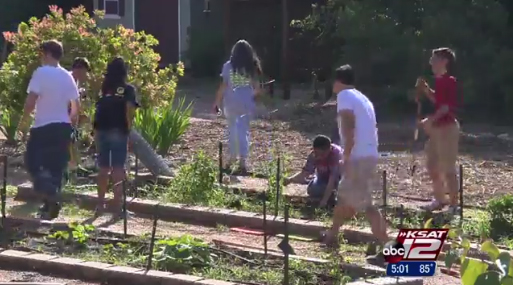
Share On Social!
 What’s a healthy, productive way to use empty space on a school campus?
What’s a healthy, productive way to use empty space on a school campus?
Students turned such a space into a sprawling community garden at Harris Middle School in San Antonio to yield a learning environment for students and fresh produce for students and nearby residents.
The students’ efforts are featured in the new “Making Awesome Changes” TV series, which partners KSAT-TV and Salud America! to feature Salud Heroes—people and groups who are pushing for healthy changes—on the evening news.
“I feel better because knowing that I helped in the creation of new vegetables, and that they are better for the environment, and they’re better for you to eat since they are organic and they taste better too,” said Miwa Stowers, an eight-grader at Harris.
 Salud America!, a Latino childhood obesity research network funded by the Robert Wood Johnson Foundation and led by the Institute for Health Promotion Research at the UT Health Science Center at San Antonio, develops Salud Heroes stories to teach people the steps that go into healthy changes and to inspire more change.
Salud America!, a Latino childhood obesity research network funded by the Robert Wood Johnson Foundation and led by the Institute for Health Promotion Research at the UT Health Science Center at San Antonio, develops Salud Heroes stories to teach people the steps that go into healthy changes and to inspire more change.
KSAT-TV has featured these other Salud Heroes:
Cecil Whisenton, a Salud America! Salud Hero, helped bring healthy vending machines to give students nutritious snack options at South San High School (KSAT-TV video).
Cesar Valdillez, aSalud America! Salud Hero, worked with neighbors and the city to start a community garden in San Antonio’s Southtown community (KSAT-TV video).
Dante Jones, a Salud America! Salud Hero, started the Roll Models bike club to mentor youth and take them on regular bike rides across San Antonio (KSAT-TV video).
Michaelie Love, a Salud America! Salud Hero, helped bring a breakfast cart with fast, low-fat, low-sugar, and whole-grain options to her school (KSAT-TV video).
Stay tuned for more stories from Salud America! and KSAT-TV!
Explore More:
Maternal & Child HealthBy The Numbers
20.7
percent
of Latino kids have obesity (compared to 11.7% of white kids)



